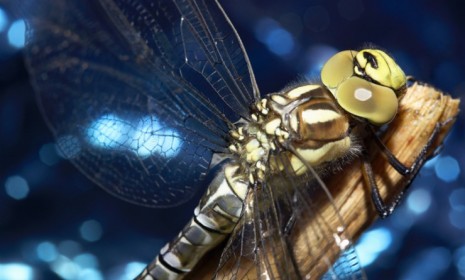Solved: How flying insects evolved from hawk-sized to tiny
Giant flying bugs once boasted massive wingspans nearing 30 inches. But 150 million years ago, they began shrinking, and now scientists think they know why

Hundreds of millions of years ago, winged insects as big as today's hawks ruled the skies. But at some point in their evolutionary history, something changed, and the giant bugs began shrinking, eventually becoming the diminutive insects we're familiar with today. Now, researchers from the University of California Santa Cruz think they know why, and it may have something to do with dinosaurs' slow evolution into birds. Here's what you should know:
What were these giant bugs like?
About 300 million years ago, a dragonfly-like insect called the griffinfly buzzed about with a fluttery wingspan of about 28 inches. Scientists believe that extra oxygen in the sky (9 percent more than exists in today's atmosphere) gave the massive bugs more energy per breath, allowing them to power larger bodies. "When oxygen went up, insects got bigger," study author Matthew Clapham tells National Geographic. But around 150 million years ago, that pattern began to change.
The Week
Escape your echo chamber. Get the facts behind the news, plus analysis from multiple perspectives.

Sign up for The Week's Free Newsletters
From our morning news briefing to a weekly Good News Newsletter, get the best of The Week delivered directly to your inbox.
From our morning news briefing to a weekly Good News Newsletter, get the best of The Week delivered directly to your inbox.
What happened?
During the Jurassic period, the first birds — like the famous Archaeopteryx — began taking flight. Strangely, animals like the griffinfly stopped growing bigger, even though oxygen levels continued to climb. The new study, published in the Proceedings of the National Academy of Sciences, suggests that big bugs may have been supplanted by these newly airborne predators.
Why did big birds replace big bugs?
The birds, much more nimble than the flying reptiles that preceded them, found it easier than previous predators to lunch on the bugs. Or it could simply be that the birds bested large insects in the battle for resources. In any case, insects like the griffinfly began to shrink, evolving features that made them harder to catch. "The maneuverability of any sort of flying thing really scales with size," says Clapham. "Small things are much more maneuverable than large things."
A free daily email with the biggest news stories of the day – and the best features from TheWeek.com
How big would insects be today if not for birds?
Clapham thinks that, given current oxygen levels, the largest bugs today could be roughly three times bigger than they are.
Sources: Mercury News, Mother Nature Network, National Geographic, Red Orbit
-
 Political cartoons for November 29
Political cartoons for November 29Cartoons Saturday's political cartoons include Kash Patel's travel perks, believing in Congress, and more
-
 Nigel Farage: was he a teenage racist?
Nigel Farage: was he a teenage racist?Talking Point Farage’s denials have been ‘slippery’, but should claims from Reform leader’s schooldays be on the news agenda?
-
 Pushing for peace: is Trump appeasing Moscow?
Pushing for peace: is Trump appeasing Moscow?In Depth European leaders succeeded in bringing themselves in from the cold and softening Moscow’s terms, but Kyiv still faces an unenviable choice